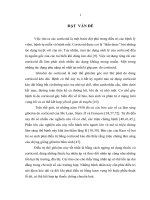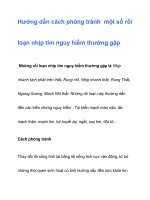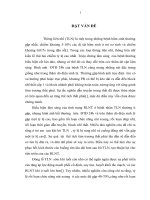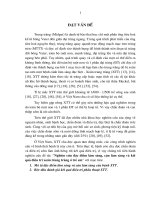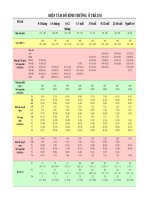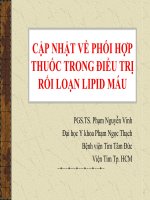Cập nhật HƯỚNG dẫn cắt đốt QUA CATHETER các rối LOẠN NHỊP ở TRẺ EM
Bạn đang xem bản rút gọn của tài liệu. Xem và tải ngay bản đầy đủ của tài liệu tại đây (272.28 KB, 30 trang )
CẬP NHẬT
HƯỚNG DẪN CẮT ĐỐT QUA
CATHETER CÁC RỐI LOẠN NHỊP
Ở TRẺ EM
BS Bùi Thế Dũng
BV Đại học Y Dược – TP. HCM
TÀI LIỆU THAM KHẢO
1. Freidman RA (2002), "NASPE Expert Consensus
Conference: Radiofrequency Catheter Ablation in
Children with and without Congenital Heart
Disease“
2. Cohen MI (2012), "PACES/HRS Expert Consensus
Statement on Asymptomatic Young Patient With
WPW Pattern"
3. Saul JP (2016), "PACES/HRS expert consensus
statement on the use of catheter ablation in children
and patients with congenital heart disease“
3 main issues
1.
2.
•
•
•
•
•
•
3.
Safety - Efficacy
Procedure:
laboratory equipment
personnel
ablation energy
catheter choice
sedation/anesthesia
pre- and post-ablation procedure management
Arrhythmia type
SAFETY - EFFICACY
The 2002 consensus: depended on patient age,
typically expressed as “< or > 5 years”
HRS 2014: 2 groups: ≤ 12 years or 12 – 18
years
The 2016 consensus: patient weight was more
important than age – chose cutoff “15 kg”
Succes rate of RFCA:
1991 – 1995 (Early Era, n=4193): 90.4%
1996 – 1999 (Late Era, n=3407): 95.2%
SAFETY - EFFICACY
2000 – 2002 (n=2761, 41 centers):
Succes rate of RFCA: 93% SVT, 78% VT
Recurrence at 12 months: 24.6% right septal
APs, 15.8% right freewall APs; 9.3% left free
wall APs, 4.8% left septal APs; 4.8% AVNRT
Complications:
1991 – 1995: 4.2%
1996 – 1999: 3%
Complications
Death and major complications:
congenital heart disease
lower patient weight
greater number of RF applications
left-sided procedures
Three most common serious complications:
AV block: 0.89 – 0.56%
Perforation or pericardial effusion: 0.69 – 0.53%
thrombi or emboli: 0.37 – 0.19%
Fluoroscopy Exposure
Deterministic effects
(threshold level is 2 Gy)
Stochastic effects
(dose independent)
Skin erythema
Malignancies: 0.02% – 0.03%
Epilation
Hereditary defects
Cataracts
Retarded bone growth
Sterility
Decreased white blood cell
Organ atrophy
Fibrosis
Techniques to Reduce
Procedure-Based Radiation
1. As Low as Reasonably Achievable (ALARA)
• Pulsed fluoroscopy
• Lower frame rate
• Adjusting collimators to decrease field view
• Limiting the use of magnification
• “store fluoro” function instead of cineangiography
• Alternating between two views rather than a single
imaging view to minimize site exposure
2. Nonfluoroscopic systems
• 3-D imaging systems + TEE or ICE
Anesthesia and Sedation
Aims: improve patient comfort, reduce movement, and
have minimal effect on the arrhythmia substrate
Personnel:
• Pts > 12 years: nurse anesthetist
• Pts ≤ 12 years: nurse anesthetist + anesthesiologist
General anesthesia with endotracheal intubation or
laryngeal mask: age ≤ 12 years, significant CHD;
ventricular dysfunction; pulmonary hypertension;
hemodynamic instability; prolonged procedure; the need
for complete immobility and patient or parent choice.
Safety Recommendations
Class I
In-house pediatric cardiovascular surgical support for
patients < 15 kg
A pediatric (or congenital) cardiovascular surgical
program at the same institution where the ablation is
performed for patients ≤ 12 years of ages
Age-appropriate cardiovascular surgical program and
back-up at the same institution where the ablation is
performed for patients from 12 to 18 years of ages
Safety Recommendations
Class I
For patients ≤ 12 years of and/or with moderate or
complex CHD, the procedure staff should have a
pediatric and/or CHD pts anesthesiologist
Fluoroscopy use should be as low as possible
Anticoagulation with unfractionated heparin: When
the procedure will take place in the left atrium or
ventricle, or there is a known or potential right-to-left
shunt to prevent systemic embolization (ACT: 250 –
300 s during procedures)
Safety Recommendations
Class IIa
Cryoablation is useful for septal substrates and
proximity to smaller coronary arteries
Class IIb
Cryoablation can be useful for pts < 15 kg
Class III
Ablation is not recommended for patients with
an intracardiac thrombus
Procedural Recommendations
Class I
EP lab and postprocedure recovery unit should be
suitable for the care of pediatric and CHD pts
Ablation for patients with moderate or complex CHD
or complex arrhythmias should be performed by an
electrophysiologist with the appropriate expertise
3D mapping system should be available and strongly
considered for mapping and ablation of postoperative
arrhythmias in patients with moderate or complex CHD
Procedural Recommendations
Class IIa
Irrigated or large electrode-tip RF catheters
can be useful for the ablation of postoperative
arrhythmias in patients with CHD
Nonfluoroscopic imaging can be useful to
reduce radiation exposure
Cryoablation can be useful for slow pathway
modification in pediatric patients with AVNRT
Clinical Presentations
1.
•
•
•
•
2.
3.
SVT
AVNRT
AVRT
AT
AFL
WPW pattern and AP mediated Tachycardias
VT
Indications for SVT Ablation
Class I
Documented SVT, recurrent or persistent associated
with ventricular dysfunction in pts > 15 kg
Documented SVT, recurrent or persistent when
medical therapy is either not effective or is intolerant
Documented SVT, recurrent or persistent when the
family wishes to avoid chronic drugs in pts > 15 kg
Recurrent hemodynamic compromise (hypotension or
syncope) from SVT in pts > 15 kg
Recurrent SVT requiring emergency medical care or
electrical cardioversion for termination in pts > 15 kg
Indications for SVT Ablation
Class II a
Recurrent symptoms clearly consistent with
PSVT in pts > 15 kg, and one of the following:
evidence of AP involvement; inducible SVT
Slow pathway modification in pts > 15 kg with
documented SVT, when SVT is not inducible
at EP testing, but evidence for dual AV nodal
physiology. Cryotherapy should be considered
Indications for SVT Ablation
Class II b
Recurrent symptoms clearly consistent with
PSVT in pts < 15 kg, and one of the following:
evidence of AP; inducible SVT.
Cryotherapy should be considered
Recurrent hypotension or syncope from SVT
in pts < 15 kg
Intermittent symptomatic SVT which is
nonsustained (less than 30s) in pts > 15kg
Indications for SVT Ablation
Class III
SVT controlled with medical therapy without
intolerable adverse effects in pts < 15 kg
Clinical symptoms consistent with SVT, but no
inducible SVT, and no evidence for dual AV
nodal physiology during EP testing
Slow pathway modification when dual AV
node physiology is demonstrated after ablation
of a different arrhythmia substrate (such as an
AP when there is no inducible AVNRT
Indications for WPW pattern Ablation
Class I
WPW pattern following cardiac arrest
WPW pattern with syncope when there are
predictors of high risk for cardiac arrest (The
shortest preexcited RR interval during AF, or
during incremental atrial pacing ≤ 250 ms;
Multiple accessory pathways)
Indications for WPW pattern Ablation
Class II a
WPW pattern with ventricular dysfunction in pts
> 15 kg, or when medical therapy is either not
effective or intolerant in pts < 15 kg
WPW pattern with predictors of high risk for
cardiac arrest in pts > 15 kg
WPW pattern with syncope, without predictors of
high risk for cardiac arrest in pts > 15 kg
Asymtomatic WPW pattern in pts > 15 kg when
the absence of WPW pattern is a prerequisite for
participation in personal or professional activities
Indications for WPW pattern Ablation
Class II b
Asymtomatic WPW pattern in pts > 15 kg
without high risk for cardiac arrest because of
a patient or family choice
Class III
WPW pattern caused by a fasciculoventricular
accessory pathway
WPW pattern without symptoms in pts < 15 kg
Indications for ablation of
ventricular arrhythmias without CHD
Class I
VPCs or VT caused ventricular dysfunction, when
medical therapy is either not effective or intolerant, or
as an alternative to medical therapy in pts > 15 kg
Recurrent or persistent symptomatic verapamil –
sensitive VT, idiopathic outflow tract VT, or VT with
hemodynamic compromise, when medical therapy is
either not effective or intolerant, or as an alternative
to medical therapy in pts > 15 kg (LOVT-VT was a
Class IIa indication in the prior pediatric guidelines)
Indications for ablation of
ventricular arrhythmias without CHD
Class II a
VPCs with correlated symptoms in pts > 15 kg
Class II b
Accelerated
idioventricular
rhythm
with
correlated symptoms in pts > 15 kg
(Class IIa in the prior pediatric guidelines)
Recurrent/frequent
polymorphic
ventricular
arrhythmia when there is a suspected triggering
focus, arrhythmia, or substrate that can be
targeted
Indications for ablation of
ventricular arrhythmias without CHD
Class III
VT in pts < 15 kg controlled medically, or is
well tolerated without ventricular dysfunction
Acc. idioventricular rhythm in pts < 15kg
Asymptomatic VPCs, VT, or accelerated
idioventricular rhythm that is not suspected of
causing or leading to ventricular dysfunction
VPCs, VT due to transient reversible causes


